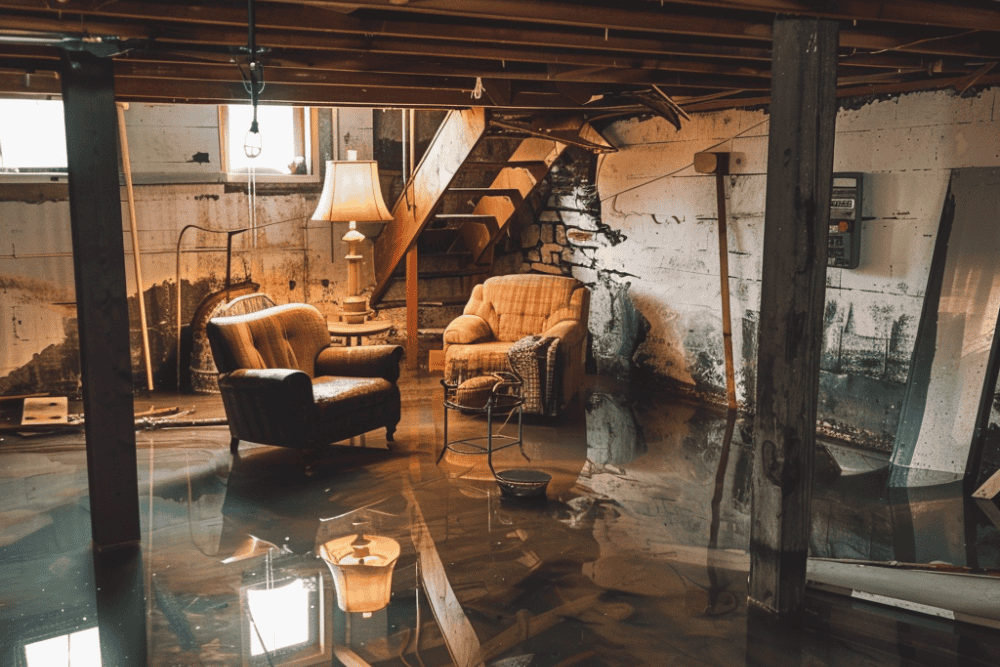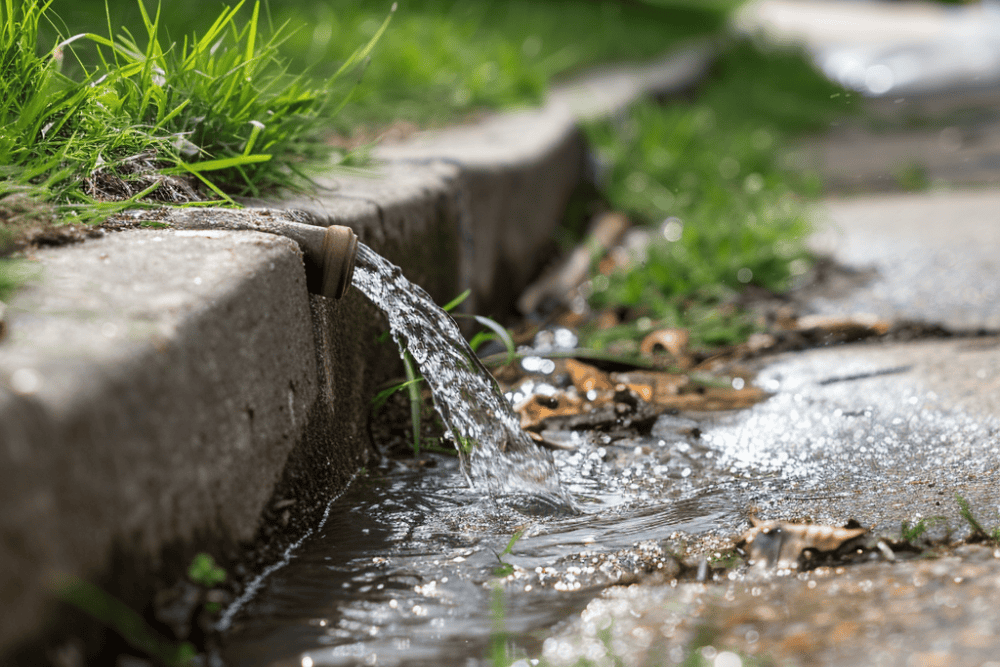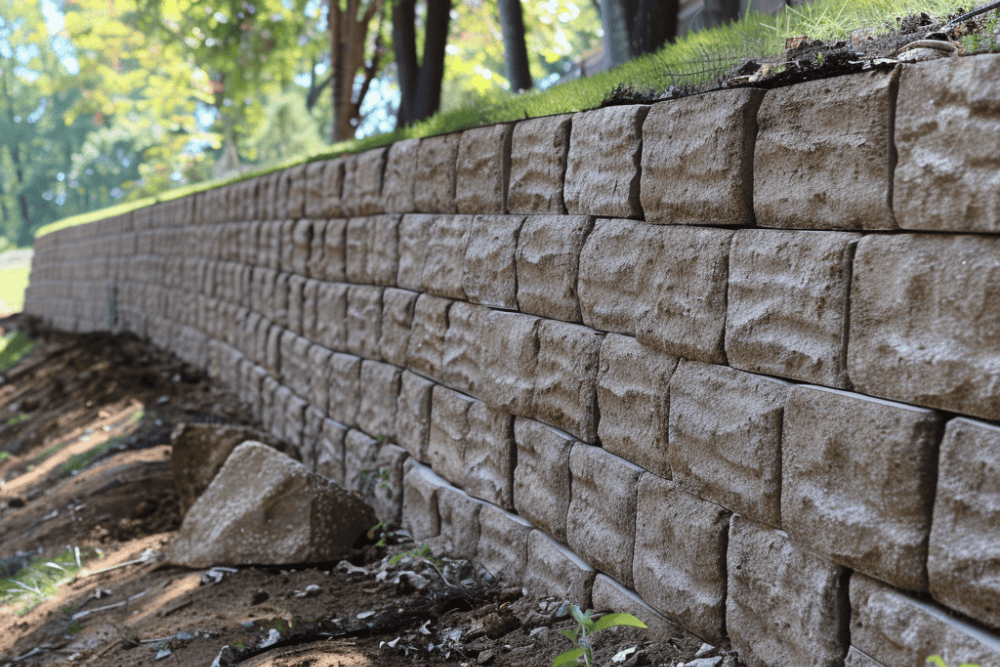French Drains in Austin
Prevent Property Damage with a French Drain
As you face drainage issues in your Austin property, consider installing a French drain. A French Drain system is a drainage solution that eliminates excess ground moisture, preventing wet basements and other common problems. French drains help avoid mold, mildew, and seeping water, maintaining a dry, healthy environment. They can also prevent you from having to deal with the extremely expensive costs of a foundation repair to address water damage in your home.

A French Drain Can Keep Water Away From Your Foundation – Avoiding Massive Expensive Headaches Like Flooded Basements
Understanding Drainage Issues
When dealing with drainage issues in your property, it’s important to recognize and address them promptly. Standing water can lead to various problems for your home and yard. In this section, we will discuss some common drainage issues and how to identify them.
First, keep an eye out for standing water in your yard. This is usually a clear sign of poor drainage. You might notice puddles forming after rain or discover that water is pooling around the foundation of your house. This can lead to structural damage, mold, and other issues if not addressed quickly.
Second, observe if your yard feels soggy or the soil is consistently wet. When drainage is insufficient, the excess water can cause your lawn to become saturated. In turn, this could weaken the roots of your grass and plants, making them more susceptible to disease and pests.
Ease of water flow is another factor to consider. Obstructions, such as debris, or incorrect grading can interfere with the natural runoff of rainwater in your yard. This might force the water to accumulate in unwanted areas, leading to further drainage complications.
Finally, be aware of any signs of erosion or soil movement around your property. Insufficient drainage can cause soil to wash away, leaving your yard vulnerable to landslides and other damage. Proper drainage solutions – especially the use of a french drain – can help prevent these issues and maintain the stability of your property.
French Drain Construction Steps
French Drain construction involves the use of specialized tools and is not recommended as a DIY project. Your landscaping pro will follow these steps below as part of a french drain installation service on your property.
Determining Slope
Before starting your drainage system installation, you need to determine the slope of your property. This is a crucial step, as it directly impacts the effectiveness of your drain. Use a level and a measuring tape to find the slope, ensuring it’s adequate for proper water flow. You’ll need at least a ¼ in drop per foot for proper drainage.
Digging the Trench
Once proper slope is established it’s time to dig the trench. The depth and width of the trench will depend on the size of the drain pipe you plan to install – but the trench will typically be about 1.5 feet deep and around a foot wide.
That requires removing a lot of earth from your yard – especially if you’re dealing with a long drain. While some of this dirt will be used for grading purposes, most will have to be discarded, which can be a challenge for homeowners undergoing a DIY french drain build.
A “gotcha” with digging trenches is that you’ll want to watch out for any of your irrigation pipes if you have inground sprinklers. You must use extreme care. Landscapers are skilled with dealing with sprinkler systems and can excavate the trench without causing damage.
Adding Gravel
After digging the trench, a layer of gravel is added. This will serve as a solid base for your perforated pipe and facilitate proper drainage of water. Use coarse gravel with a size of about 1-2 inches for the best results. Pea gravel is ideal for this purpose.
Installing Perforated Pipe
Next, you’ll need to place a perforated pipe in the trench on top of the gravel layer. Ensure that the holes in the pipe are positioned downward to allow water to flow into the drain while keeping debris out. Secure the pipe in place using pipe clips or straps if necessary.
Note that this perforated pipe should be fully contained by a mesh “sock” the sock helps to keep large debris out of the pipe and prevents clogs from ever forming.
Covering with Gravel
Finally, cover the entire perforated pipe with more gravel, completely filling the trench. This layer of gravel will ensure that water can easily flow into the pipe and away from your property. Once the gravel is in place, finish the project by covering the gravel with soil or grass to blend the drain seamlessly into your landscape.

Once Installed, a French Drain Will Whisk Water Away From Your Property and Neighboring Properties to Avoid Potential Water Damage and Erosion
French Drain Applications
- Next to Your House – A frequent place to install french drains is in close proximity to your house. A french drain can serve as a barrier preventing water from seeping into your basement and preventing your sump pump from being overworked.
- In Your Yard – Pooling in the middle of your yard can be solved with a french drain. A catch basin can be installed where water pools, that will allow safely whisk water away and prevent it from causing erosion or hollowing out low spots in your yard.
- Along the Base of a Retaining Wall – A french drain is oftentimes installed at the base of a retaining wall to prevent water from accumulating at the base of the wall and applying pressure to the wall that can shorten the lifespan of the wall.

A French Drain Can be Used to Alleviate the Pressure on the Base of a Retaining Wall by Guiding the Water Away from the Wall and to a Location Where it Can Drain Safely Away
Benefits of French Drains
Prevention of Bigger, More Costly Problems: French drains offer a highly efficient way to control excess water on your property. By capturing and redirecting water, you protect your property from issues like soil erosion, foundation damage, and waterlogged lawns.
Versatility: French drains can be customized to meet the specific requirements of your property. Their adaptable nature allows them to be installed in various locations and configurations, providing tailored solutions for different water management needs.
Low Maintenance: Once a French drain is installed, it requires minimal upkeep. You may periodically do a bit of drain cleaning at the entry point if leaves and debris accumulate. The underground design and use of gravel to filter out debris help prevent clogging, ensuring that the drain remains functional and effective for many years.
Frequently Asked Questions
What are the average rates for French drain installation in Texas?
The national average cost of a french drain is around $5,000. This can be significantly cheaper – or significantly more expensive for your Austin home depending on variables like length of your French drain.
What are the key differences between trench drains and French drains?
Trench drains and French drains serve similar purposes in managing excess water, but they differ in design and function. A trench drain is typically a linear above ground channel with a grate on top that collects surface water, while a French drain works its magic below ground by using a perforated pipe buried in gravel to capture and divert groundwater away from your property.
What factors make a French drain installation worth the investment?
A French drain is worth the investment if your property has a consistently wet basement, insufficient slope for natural drainage, or standing water in your yard. Installing a French drain can prevent structural damage to your home, protect your foundation, and improve your landscape’s aesthetics and usability.
Which local drainage experts in Austin are recommended for French drain construction?
To get in touch with a french drain expert, call us or fill out the form at the bottom of this page.
French Drains
Interested in Getting a French Drain to Channel Water Away From the House and Keep Water from Pooling? We Can Help!

DIY Yard Care
Check out our blog for information on how to do upkeep around your yard. Tips and tricks for keeping your lawn, plants and trees healthy.

Austin Events Calendar
A monthly listing of the events for you and your family to enjoy in and around Austin

COMPLETE LIST OF ALL SERVICES
All Services
Click a Link Below for More Information About Services Provided
Hardscaping
Curbing
Decks
Fence Maintenance & Install
Fire Pits
Landscape Lighting
Outdoor Kitchens
Patios
Pergolas & Gazebos
Retaining Walls
Walkways
Sprinkler Systems
General
Fall Cleanup-Leaf Removal
Landscape Design
Mulching
Organic Landscaping
Spring Cleanup
Water Features
Xeriscaping
Trees, Shrubs & Perennials
Flower Beds & Planters
Hedge & Shrub Trimming
Stump Grinding
Tree Planting
Tree Removal
Tree Trimming & Pruning
Lawn Maintenance
Lawn Aeration
Lawn Dethatching
Lawn Edging
Lawn Fertilization
Lawn Mowing
Pest Control
Weed Control
Drainage Issues
Sod & Turf
OUR SERVICE AREA
Serving Austin and Surrounding Suburbs
The perfect Austin landscaper for your needs.
For more information, click on your community below
LET’S GET STARTED
Contact Us
Austin Landscaping Lynx
Phone:
512.357.7927
Email:
operations@austinlandscapinglynx.com
Hours:
Sun – Sat: 8am – 6pm